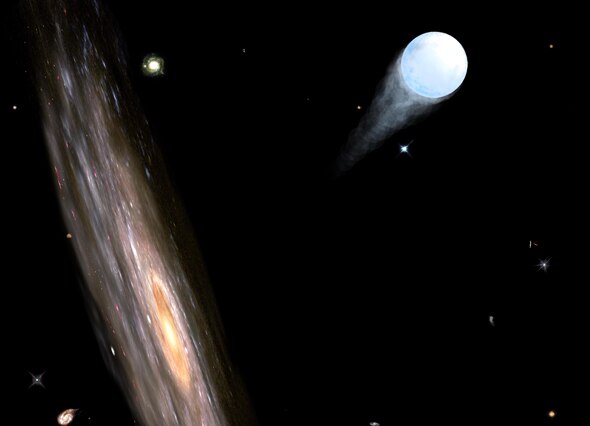Create a free profile to get unlimited access to exclusive videos, sweepstakes, and more!
Epic Tantrums Get Stars Kicked Out ... of the Galaxy

The Universe is weird.
For example, you may know that all the stars you see in the sky are part of the Milky Way galaxy. The few thousand we see with our naked eyes are a teeny tiny fraction of the several hundred billion stellar denizens of the galaxy, all orbiting around the galactic center, similar to the way planets orbit the Sun.
However, not all stars we see are like that. Some are not orbiting the center of the Milky Way. Instead, theyâre on their way out. And fast.
Literally, when the trajectories of these stars are determined, they donât move on elliptical paths around the center of the galaxy, but instead are on escape paths, literally ejected out the Milky Way at high speed. These hypervelocity stars, as theyâre called (which is awesome), tend to be high-mass hot stars, and some have been seen to be moving at 700 kilometers per second (1.5 million miles per hour!). They also appear to be heading directly away from the galactic center, indicating something there must have kicked them out. We know thereâs a supermassive black hole in the galactic heart, and that provides a mechanism to eject stars. If two stars orbit each other (a binary system) and they pass too close to the black hole, one can fall in while the other gets a huge boost to its velocity, kicking it right out of the galaxy.
But now a new class of hypervelocity stars has been discovered, and they donât fit that scenario. These stars, 20 in all, are more like the Sun: lower mass, cooler stars. And very few if any appear to be directly heading away from the galactic center, which they would be if the black hole there flicked them away. Something else must be behind this mass exodus.
My guess is that each of these stars used to be in a binary system, but the other star was a beefy, high mass star. If the stars were close enough together, theyâd orbit each other quite rapidly. When the big star exploded as a supernova, the smaller one could get flung away, a victim of centrifugal force. It was their mutual gravity that held them together; when the big star exploded, it lost most of its mass and the binds that tie were severed. The smaller star gets literally slingshot away, flying out of the galaxy, never to return.
Iâll note we do sometimes see stars screaming away from supernova explosions like cannonballs, but those are usually the leftover cinder from the star that blew up; the supernova can be a bit off-center, giving huge thrust to the remaining, dense core of the exploded star, flinging it away.
But these stars are different, since theyâre otherwise normal-appearing stars like the Sun. The authors of the study mention this supernova slingshot mechanism as one possible explanation for these stars, as well as a handful of other potential mechanisms (like multiple encounters with other stars in densely populated globular clusters, or single stars that got too close to binary black holes, a twist on the scenario described earlier). I think the supernova origin is the most likely. Interestingly, there might be a way to tell; the direction of the star could be backtracked to a known supernova site (though thatâs very tricky indeed to do), or spectra of the stars could be taken to look for tell-tale signs of contamination from nearby exploding starsâwhen stars explode, they create new elements you wouldnât expect to see in an otherwise normal star.
This is all pretty wild. It means intergalactic space is certainly littered with rogue stars, booted out of their parent galaxies by black holes, exploding stars, and perhaps other means as well. Itâs possible stars like that could, under some circumstances, hold on to their planets. What would their sky look like? Instead of stars spread across the sky punctuating the milky stream of a galaxy as we see from Earth, theyâd see a velvet black vault, with the faint fuzzy glow of the galaxy behind them, distributed over half their view.
I wonder what mythologies would arise from intelligent life developing on such a world? Would they still have a pantheon of multiple gods, or would they have just a single, lurking, menacing figure; half-glimpsed, always watching, but never changing?
⦠Or would their tales be eerily familiar? Getting kicked out of a nice place by an unseen and powerful force may be a more common story than we might suppose.


























